You can monitor work stress and boost mental clarity using seven cutting-edge devices: HRV smartwatches that track your autonomic nervous system, AI-powered wristbands achieving 91% accuracy in stress detection, biometric sensors monitoring skin conductance and temperature, cloud-integrated trackers with personalized algorithms, advanced fitness devices combining mindfulness practices, machine learning wearables recognizing behavioral patterns with 87% precision, and professional-grade monitors designed for extreme workplace conditions. These technologies transform how you’ll manage stress proactively.
Heart Rate Variability Smartwatches for Real-Time Stress Detection
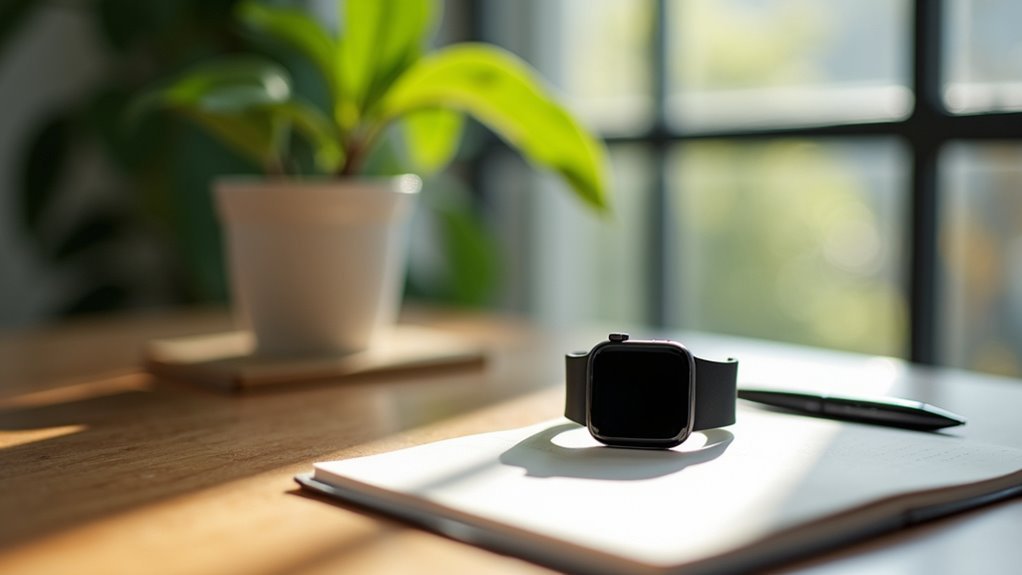
While traditional stress detection methods required clinical settings and expensive equipment, modern HRV smartwatches now bring sophisticated stress monitoring directly to your wrist.
These devices use photoplethysmography technology to measure fluctuations between heartbeats, providing continuous real-time monitoring of your autonomic nervous system activity. You’ll receive immediate alerts when stress levels rise, enabling proactive wellness management throughout your workday.
HRV smartwatches deliver instant stress alerts through advanced photoplethysmography, empowering you to manage wellness proactively before stress overwhelms your system.
The PPG sensors shine light into your skin to detect blood flow changes, while advanced algorithms convert raw data into meaningful HRV metrics instantly.
You can establish personal stress baselines and track patterns over time through user-friendly interfaces. Though they’re not medical-grade diagnostics, these smartwatches effectively monitor wellness trends and help you identify recovery needs before stress impacts your mental clarity.
Research demonstrates that higher HRV measurements typically indicate better stress resilience and improved ability to handle workplace pressures.
AI-Powered Wristbands That Monitor Physiological Stress Indicators
Beyond simple heart rate tracking, AI-powered wristbands now analyze multiple physiological stress indicators simultaneously to deliver extensive wellness insights.
You’ll receive real-time monitoring of pulse rate, oxygen saturation, skin conductance, and respiration patterns. These devices achieve impressive 91% accuracy in controlled environments and 76% during real-world validation through machine learning algorithms that establish your baseline physiological state.
The wristbands continuously collect data and provide immediate feedback when stress levels spike. You can take action before stress escalates into burnout. Research applications have demonstrated successful stress detection in real-world settings using advanced wearable technology.
These cost-effective solutions offer personalized recommendations for stress reduction and help optimize your sleep quality.
- Ultra-short pulse variability analysis detects stress patterns within minutes rather than hours
- Emergency-grade monitoring provides hospital-level accuracy in workplace environments
- Predictive stress alerts warn you before physiological stress peaks occur
- Lightweight algorithms guarantee continuous monitoring without draining battery life
Biometric Sensors in Wearables for Continuous Mental State Assessment

Your wearable device’s heart rate variability (HRV) tracking reveals essential insights into your autonomic nervous system’s balance, serving as a key biomarker for stress levels throughout your workday.
When you’re experiencing stress, your HRV patterns change dramatically, and advanced algorithms can detect these shifts in real-time to alert you before stress escalates.
You’ll receive immediate feedback about your mental state, allowing you to implement stress-reduction techniques or take breaks when your biometric data indicates elevated stress indicators. These devices also monitor skin conductance levels, which provide additional physiological signals that complement HRV data for more comprehensive stress detection.
Heart Rate Variability Tracking
As technology advances in workplace wellness monitoring, heart rate variability (HRV) tracking has emerged as one of the most sophisticated methods for evaluating your mental state throughout the workday.
HRV measures the variation between heartbeats, providing essential insights into your autonomic nervous system function. Modern wearable devices like Apple Watch, Garmin, and specialized trackers such as Whoop continuously monitor these patterns, helping you understand stress levels and recovery needs.
By establishing your personal baseline, you’ll receive real-time feedback about how work pressures affect your physiological state. Higher HRV scores typically indicate improved vagal tone and better stress resilience in demanding work environments.
- Stress Pattern Recognition: Track daily stress fluctuations to identify workplace triggers and optimize your response strategies
- Recovery Optimization: Monitor overnight HRV to determine if you’re adequately recovering from work-related stress
- Performance Timing: Use HRV data to schedule demanding tasks during peak mental clarity periods
- Intervention Alerts: Receive notifications when stress levels spike, prompting immediate mindfulness or breathing exercises
Real-Time Stress Detection
Modern wearable devices equipped with advanced biometric sensors take stress monitoring several steps further by detecting your mental state changes as they happen. These devices continuously capture physiological indicators like galvanic skin response, skin temperature, and electrodermal activity through wristbands, chest straps, and smartwatches.
Embedded processors analyze this biometric data in real-time using machine learning algorithms trained on physiological datasets from stressful episodes. You’ll receive immediate notifications when elevated stress levels are detected, enabling prompt intervention before symptoms worsen.
The systems combine multiple biometric signals for enhanced reliability and pair behavioral data with activity tracking for context-aware assessments. This continuous feedback increases your self-awareness and promotes proactive stress management, while machine learning models adapt and improve accuracy as they collect more personalized data. Unlike traditional 12-lead ECG systems that are immobile and require trained experts for interpretation, wearable devices provide accessible continuous monitoring for everyday use.
Cloud-Integrated Devices With Personalized Stress Management Algorithms
While traditional stress monitoring relied on periodic check-ins and self-reporting, cloud-integrated devices now transform how you manage workplace stress through continuous, intelligent monitoring.
These sophisticated systems combine IoT sensors with machine learning algorithms to analyze your physiological data in real-time. Your wearable device captures multiple stress indicators like heart rate variability, body temperature, and blood oxygen saturation, transmitting this data to cloud servers for processing.
Modern wearables continuously track your stress biomarkers, sending real-time physiological data to cloud platforms for instant analysis and personalized insights.
The cloud’s computational power enables personalized feedback by considering contextual factors such as your location and environmental conditions. Machine learning algorithms adapt to your unique stress patterns, categorizing your stress levels into manageable tiers and providing tailored recommendations through user-friendly mobile applications. Professional monitoring systems can connect via Bluetooth connectivity to wall-mounted tablets for enhanced workplace safety management.
- Serverless architecture guarantees scalable data processing without infrastructure limitations
- Dynamic query systems adjust monitoring frequency based on your daily stress patterns
- Signal quality indices maintain accurate data collection for reliable feedback
- Long-term data storage enables thorough stress trend analysis and offline access
Advanced Fitness Trackers Combining Mindfulness and Stress Monitoring
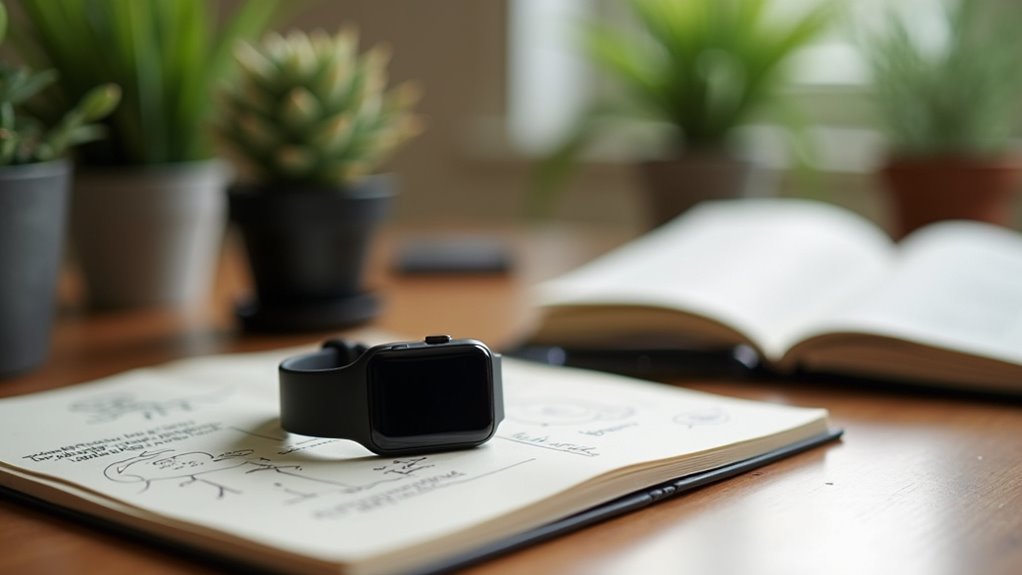
Beyond basic activity tracking, today’s advanced fitness trackers revolutionize workplace wellness by seamlessly integrating sophisticated stress monitoring with guided mindfulness practices.
You’ll find devices like Fitbit using continuous electrodermal activity sensors to detect stress responses through skin conductivity changes, while Garmin tracks heart rate variability to provide objective stress measurements. The Oura Ring monitors body temperature fluctuations that indicate stress or illness.
These trackers don’t just identify stress—they actively help you manage it. You’ll receive real-time stress alerts that prompt breathing exercises and guided meditation sessions.
Your device creates personalized stress management plans based on your unique data patterns, while mood logging features help you identify specific triggers. This data-driven approach enhances your stress awareness, promotes mindfulness practices, and supports long-term mental clarity improvements through consistent monitoring. Understanding your personal stress baselines becomes crucial for effective stress management and interpreting the data these devices provide.
Machine Learning Wearables for Behavioral Pattern Recognition
Machine learning algorithms transform how wearable devices interpret your daily behaviors, moving far beyond simple stress detection to recognize complex patterns in everything from your eating habits to subtle signs of agitation or fatigue.
These personalized ML models achieve impressive 0.87 AUC accuracy rates by analyzing data from accelerometers, gyroscopes, and heart rate monitors simultaneously.
Sophisticated machine learning algorithms deliver exceptional 87% accuracy by seamlessly integrating multiple sensor streams for comprehensive behavioral pattern analysis.
Advanced disentanglement techniques separate meaningful behavioral signals from environmental noise, ensuring your device recognizes true stress patterns rather than responding to irrelevant factors.
This continuous, minute-to-minute monitoring enables timely interventions when behavioral changes indicate mounting work pressure. These systems function as digital biomarkers that can identify early indicators of mental health issues before they escalate into more serious conditions.
- Multimodal sensor fusion combines accelerometer, gyroscope, and heart rate data for thorough behavioral analysis
- Personalized ML models adapt to your unique behavioral signatures and stress responses
- Real-time pattern recognition detects subtle changes in movement, heart rate variability, and activity levels
- Noise filtering algorithms distinguish genuine stress signals from environmental or personal factors
Professional-Grade Stress Monitoring Devices for High-Performance Workplaces
When your workplace demands peak performance under extreme conditions, professional-grade stress monitoring devices deliver the precision and durability that consumer wearables simply can’t match.
These devices use Wet Bulb Globe Temperature (WBGT) and heat index metrics to assess environmental stress accurately. With IP54 ingress protection ratings, they’re built for harsh work environments while maintaining real-time data logging capabilities.
You’ll benefit from multi-sensor wearables that capture heart rate variability and temperature fluctuations, integrating physiological data with environmental conditions.
AI-enhanced algorithms differentiate between acute and chronic stress responses, providing actionable insights through safety dashboards. This technology helps you maintain compliance with OSHA regulations while reducing workplace injuries. Advanced systems connect via Bluetooth connectivity to wall-mounted tablets, enabling real-time remote monitoring of critical environmental data.
The continuous monitoring preserves mental clarity during critical tasks, preventing cognitive decline and ensuring peak performance when it matters most.
Frequently Asked Questions
How Much Do Professional Work Stress Monitoring Devices Typically Cost?
You’ll find professional work stress monitoring devices range from $100 for basic wearable models to over $300 for advanced systems with AI analytics and biosensors, depending on features and brand sophistication.
Are Stress Monitoring Devices Covered by Employee Health Insurance Plans?
You’ll find stress monitoring devices are sometimes covered under extensive employee health insurance plans with wellness programs. Coverage varies widely among providers, with some offering incentives or discounts for participating.
What Privacy Protections Exist for Biometric Data Collected by Workplace Wearables?
You’re protected by laws like Illinois BIPA requiring explicit consent before biometric collection. Employers must implement strong security measures, limit data retention, provide clear notice, and follow state-specific privacy regulations governing workplace wearables.
How Long Does the Battery Last on Continuous Stress Monitoring Devices?
You’ll get 18 hours from Apple Watch, up to 14 days from Garmin, and 7 days from Fitbit with continuous stress monitoring. However, you’ll likely need daily charging since continuous monitoring drains batteries faster.
Can Employers Legally Require Workers to Wear Stress Monitoring Devices?
You’ll find employers can legally require stress monitoring devices in most states, but you must receive notification in Connecticut, Delaware, Texas, and New York. Union consent’s required for unionized workers.


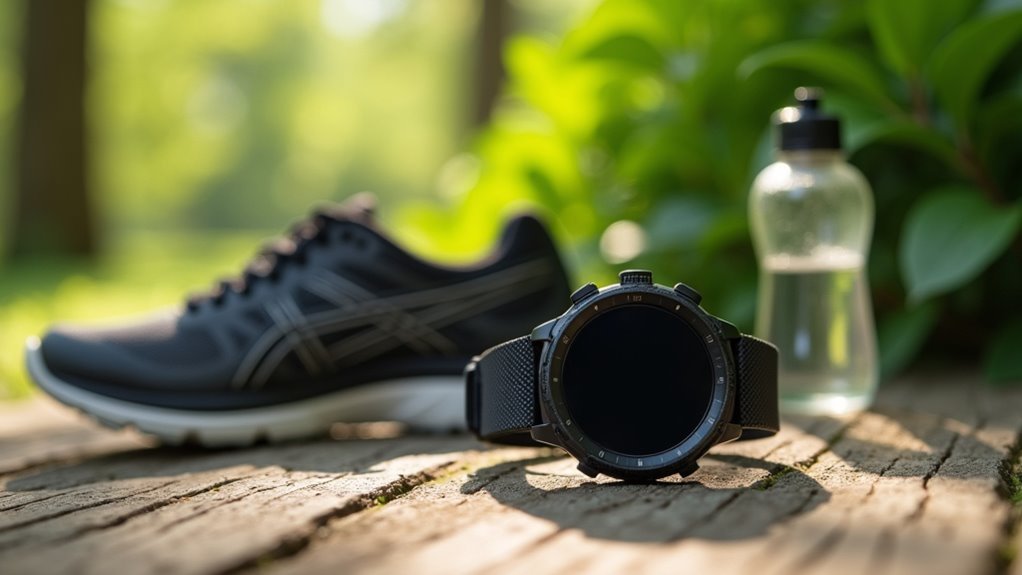
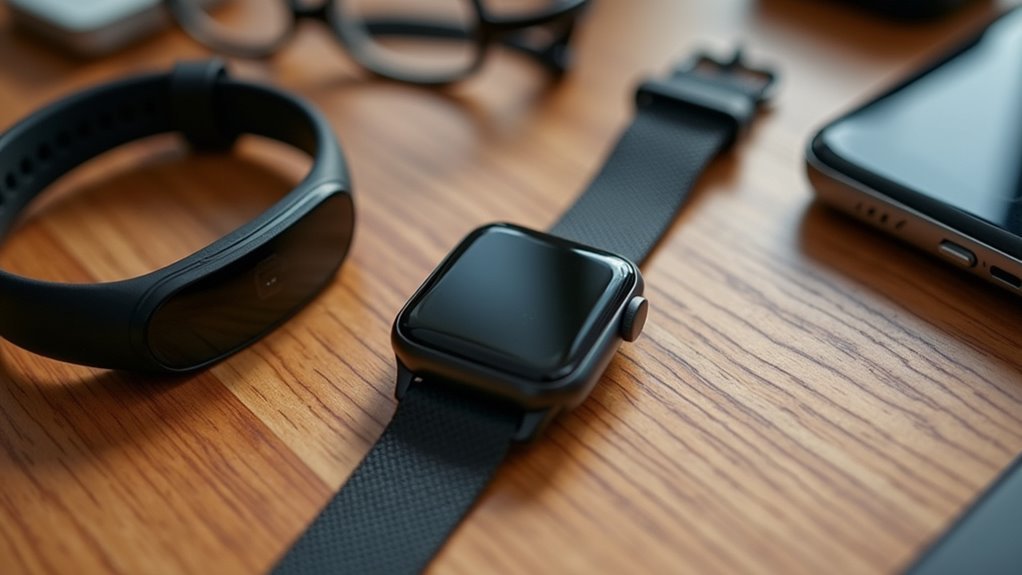
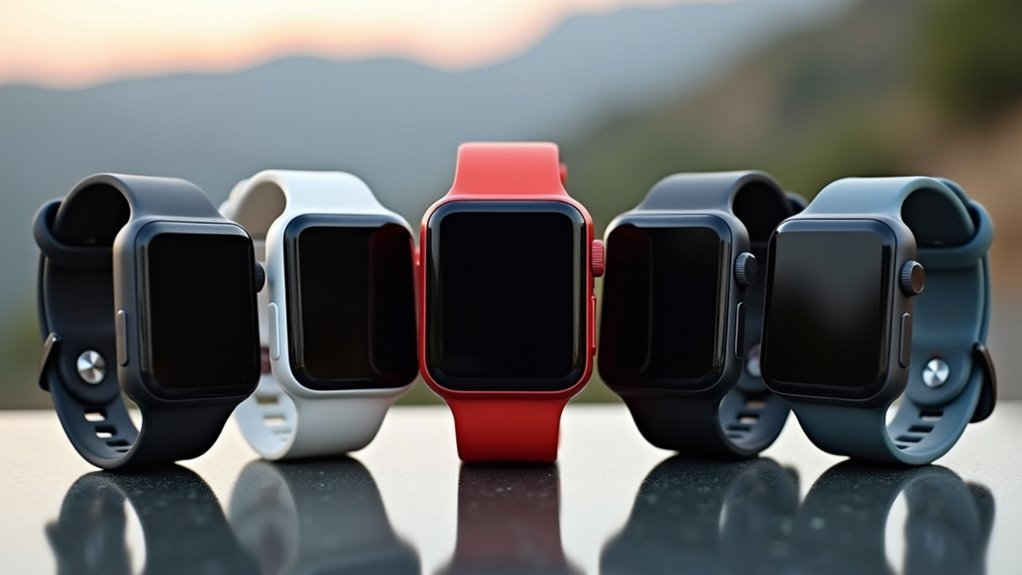
Leave a Reply